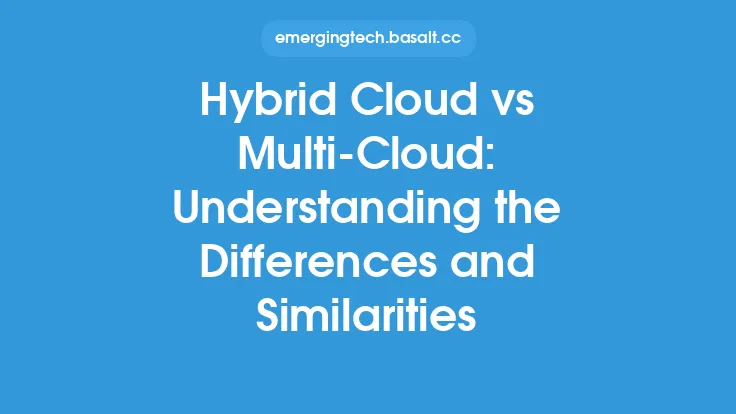In today's cloud computing landscape, organizations are increasingly adopting multi-cloud environments to leverage the benefits of different cloud providers, such as Amazon Web Services (AWS), Microsoft Azure, Google Cloud Platform (GCP), and IBM Cloud. A multi-cloud environment allows businesses to choose the best services from each provider, optimize costs, and improve overall efficiency. However, managing multiple cloud services from different providers can be complex, and interoperability becomes a critical factor in ensuring seamless communication and data exchange between these services. Interoperability refers to the ability of different systems, applications, or services to communicate and exchange data with each other, regardless of their underlying infrastructure or technology stack.
What is Interoperability in Multi-Cloud Environments?
Interoperability in multi-cloud environments is the ability of different cloud services, applications, or systems to communicate, exchange data, and work together seamlessly, despite being hosted on different cloud providers. This enables organizations to integrate services from multiple providers, creating a cohesive and efficient IT infrastructure. Interoperability is essential in multi-cloud environments because it allows businesses to take advantage of the unique features and strengths of each cloud provider, while minimizing the risks associated with vendor lock-in. By ensuring interoperability, organizations can avoid being tied to a single cloud provider, reducing the risk of data silos and improving overall flexibility.
Benefits of Interoperability in Multi-Cloud Environments
The benefits of interoperability in multi-cloud environments are numerous. Some of the key advantages include:
- Improved flexibility: Interoperability allows organizations to choose the best services from each cloud provider, optimizing costs and improving overall efficiency.
- Enhanced scalability: By integrating services from multiple providers, businesses can scale their infrastructure more easily, responding to changing demands and requirements.
- Increased agility: Interoperability enables organizations to quickly deploy new applications and services, improving time-to-market and competitiveness.
- Better data management: Interoperability facilitates the exchange of data between different cloud services, enabling organizations to manage their data more effectively and make informed decisions.
- Reduced vendor lock-in: By ensuring interoperability, businesses can avoid being tied to a single cloud provider, reducing the risk of data silos and improving overall flexibility.
Technical Challenges of Interoperability in Multi-Cloud Environments
While interoperability is essential in multi-cloud environments, it also presents several technical challenges. Some of the key challenges include:
- Different APIs and data formats: Cloud providers use different APIs and data formats, making it difficult to integrate services and exchange data.
- Security and authentication: Ensuring security and authentication across multiple cloud providers can be complex, requiring careful planning and implementation.
- Network and connectivity issues: Integrating services from multiple providers can require complex network configurations, leading to connectivity issues and performance problems.
- Data consistency and integrity: Ensuring data consistency and integrity across multiple cloud services can be challenging, requiring careful data management and synchronization.
Strategies for Achieving Interoperability in Multi-Cloud Environments
To achieve interoperability in multi-cloud environments, organizations can adopt several strategies. Some of the key strategies include:
- Using standardized APIs and data formats: Adopting standardized APIs and data formats, such as RESTful APIs and JSON, can simplify integration and data exchange between cloud services.
- Implementing cloud-agnostic architectures: Designing cloud-agnostic architectures can help organizations avoid vendor lock-in and improve interoperability.
- Using cloud-based integration platforms: Cloud-based integration platforms, such as iPaaS (Integration Platform as a Service), can simplify integration and data exchange between cloud services.
- Developing custom integrations: Developing custom integrations using programming languages, such as Java or Python, can provide more control and flexibility, but requires more expertise and resources.
Best Practices for Ensuring Interoperability in Multi-Cloud Environments
To ensure interoperability in multi-cloud environments, organizations should follow several best practices. Some of the key best practices include:
- Carefully evaluating cloud providers: Organizations should carefully evaluate cloud providers, considering factors such as APIs, data formats, security, and authentication.
- Developing a comprehensive integration strategy: Developing a comprehensive integration strategy can help organizations ensure interoperability and simplify integration.
- Using cloud-based monitoring and management tools: Cloud-based monitoring and management tools can help organizations monitor and manage their multi-cloud environment, ensuring interoperability and performance.
- Providing training and support: Providing training and support for IT staff can help organizations ensure that they have the necessary skills and expertise to manage and maintain their multi-cloud environment.
Conclusion
In conclusion, interoperability is a critical factor in multi-cloud environments, enabling organizations to integrate services from multiple cloud providers, optimize costs, and improve overall efficiency. While interoperability presents several technical challenges, organizations can adopt strategies such as using standardized APIs and data formats, implementing cloud-agnostic architectures, and using cloud-based integration platforms to achieve interoperability. By following best practices, such as carefully evaluating cloud providers, developing a comprehensive integration strategy, and using cloud-based monitoring and management tools, organizations can ensure interoperability and simplify integration in their multi-cloud environment. As the cloud computing landscape continues to evolve, interoperability will become increasingly important, enabling organizations to take advantage of the unique features and strengths of each cloud provider, while minimizing the risks associated with vendor lock-in.





